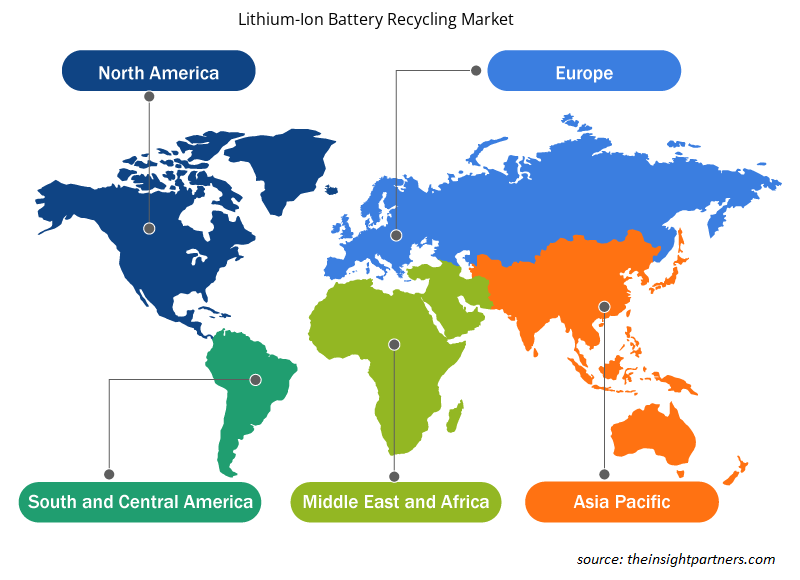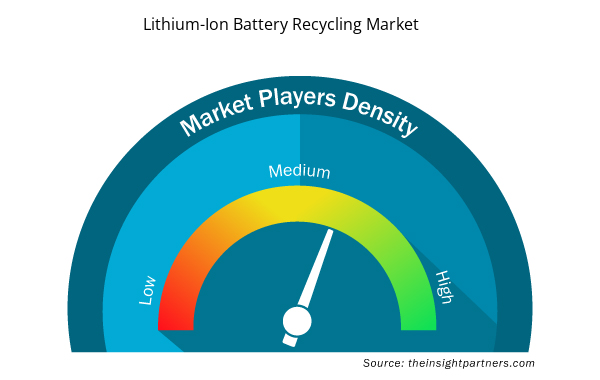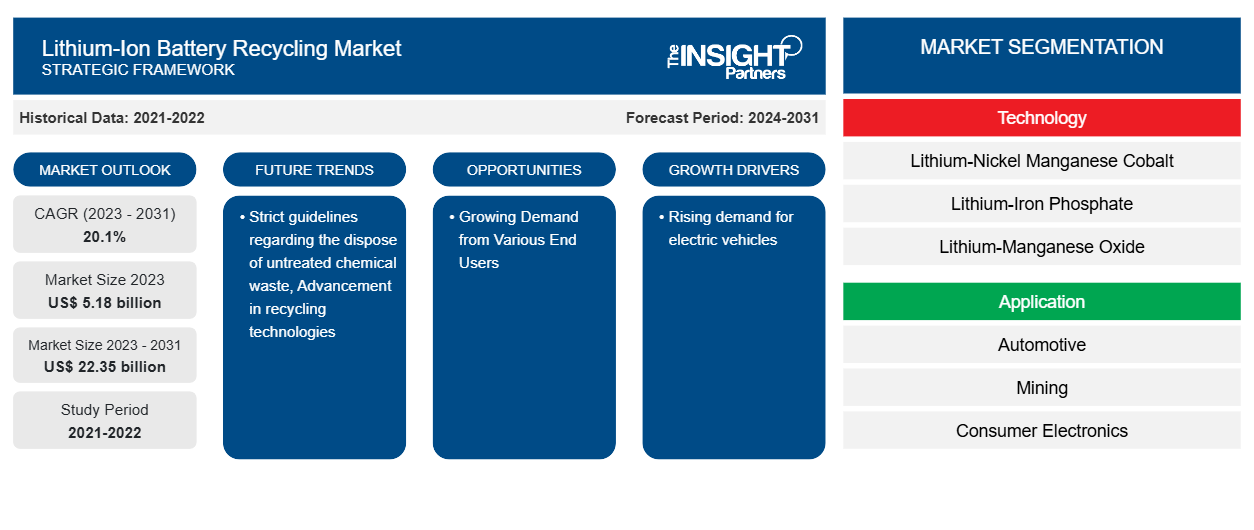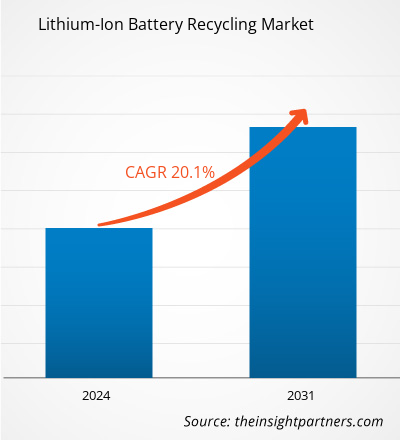Se espera que el tamaño del mercado de reciclaje de baterías de iones de litio crezca de 5.180 millones de dólares en 2023 a 22.350 millones de dólares en 2031; se estima que crecerá a una CAGR del 20,1% entre 2023 y 2031. Es probable que las estrictas directrices sobre la eliminación de residuos químicos no tratados y los avances en las tecnologías de reciclaje sigan siendo tendencias clave en el mercado del reciclaje de baterías de iones de litio.
Análisis del mercado de reciclaje de baterías de iones de litio
En los últimos años, el sector del automóvil ha experimentado un enorme aumento de la demanda de baterías de iones de litio recicladas, en particular en Estados Unidos, Alemania, Suecia, Noruega, los Países Bajos y China, así como en algunos países en desarrollo del sudeste asiático. La AIE informa de que, en comparación con 2020, las ventas de coches eléctricos casi se duplicaron hasta alcanzar los 6,6 millones (o casi el 9 %) en 2021, con un total de 16,5 millones de coches eléctricos en circulación. Además, la AIE prevé que en 2030 habrá más de 300 millones de vehículos eléctricos en circulación, lo que probablemente conducirá a un aumento del reciclaje de baterías de iones de litio. En esencia, se espera que el creciente conocimiento de los consumidores sobre los efectos ambientales positivos de los vehículos eléctricos de los países en desarrollo de la región estimule el crecimiento de la industria. Los fabricantes se están concentrando en el reciclaje de baterías de iones de litio usadas para satisfacer la demanda de las mismas en los coches.
Descripción general del mercado de reciclaje de baterías de iones de litio
Una batería de iones de litio (LIB) es un tipo de celda electroquímica que contiene componentes como electrodos y catalizadores para respaldar la generación de energía para una variedad de aplicaciones. Los tubos del cátodo y el ánodo contienen una variedad de metales preciosos con reservas finitas y precios de reventa altos. Como resultado, el proceso de reciclaje de baterías de iones de litio se utiliza para recuperar y vender las materias primas recolectadas en la composición del electrodo, lo que reduce el costo y el impacto generales del proyecto. Estas causas ayudarán al crecimiento del mercado de reciclaje de baterías de iones de litio .
El creciente uso de baterías de iones de litio en diversas aplicaciones ha suscitado preocupaciones sobre la escasez de este metal básico. La extracción de este metal tiene efectos negativos sobre el medio ambiente, incluida la contaminación del agua por fugas de sustancias químicas. Como resultado, el reciclaje de baterías de iones de litio ha aumentado recientemente. Además, dado que actualmente ningún otro material ofrece propiedades similares al litio, los fabricantes de baterías se centran cada vez más en la reutilización de baterías de litio para proporcionar una cantidad adecuada de metal para baterías de diversos usos. En este sentido, la empresa química alemana BASF anunció en junio de 2021 sus planes de iniciar la construcción de una nueva planta de reciclaje de baterías y producción de prototipos en su planta de material activo de cátodo (CAM) en Schwarzheide. Cuando las baterías de iones de litio lleguen al final de su vida útil, la empresa pretende extraer cobalto, manganeso, litio y níquel mediante un método mejorado.BASF announced plans in June 2021 to begin construction of a new battery recycling and prototype production plant at its cathode active material (CAM) facility in Schwarzheide. When lithium-ion batteries reach the end of their useful life, the company intends to extract cobalt, manganese, lithium, and nickel using an enhanced method.
Personalice este informe según sus necesidades
Obtendrá personalización en cualquier informe, sin cargo, incluidas partes de este informe o análisis a nivel de país, paquete de datos de Excel, así como también grandes ofertas y descuentos para empresas emergentes y universidades.
- Obtenga las principales tendencias clave del mercado de este informe.Esta muestra GRATUITA incluirá análisis de datos, desde tendencias del mercado hasta estimaciones y pronósticos.
Factores impulsores y oportunidades del mercado del reciclaje de baterías de iones de litio
La creciente demanda de vehículos eléctricos favorecerá el crecimiento del mercado
The rising popularity of electric vehicles is one of the main factors driving the lithium-ion battery recycling market. With the increasing volume of electric vehicles manufactured and sold, the need to recycle batteries at the end of their life cycle has become increasingly important. With collective awareness of environmental issues and the impact of greenhouse gas emissions, there is a global movement towards cleaner and more sustainable transportation options. The electric vehicle has proven to be a viable alternative to conventional internal combustion engines due to its zero emissions. Continuous improvements in battery technology and electric vehicle design have increased driving range, reduced charging time, and improved the overall performance of electric vehicles. This has made electric cars more practical and attractive to a wider demographic, increasing demand. The utility of lithium-ion batteries in electric vehicles is increasing. The utilization of electric vehicles is increasing due to an array of factors, such as lower energy efficiency, pollution, and consumer acceptance, which are among the factors driving the adoption of lithium-ion batteries. The development of advanced battery technology and the minimal maintenance requirements of these lithium-ion batteries are also contributing factors to the growth of electric vehicles. Therefore, the lithium-ion battery recycling market is projected to continue to increase due to the increasing use of lithium-ion batteries.
According to estimates of BILITI Electric, there are approximately 3 million (55,555) electric vehicles in the United States or approximately 1% of the total number of vehicles on the road. In 2022 alone, 55,555 companies produced approximately 442,000 electric vehicles. This indicates a significant increase in the production of electric vehicles by automakers.
Growing Demand from Various End Users - An Opportunity in the Lithium-Ion Battery Recycling Market
The electrical and electronics sector is among the biggest users of lithium-ion batteries because of its use in tablets, computers, mobile phones, and other electronic devices. The need for these energy sources has increased due to the expansion of the electrical and electronics industries, especially in the growing APAC countries like China, India, and Japan. Furthermore, the market for recycled lithium-ion batteries has a great chance of expanding in the upcoming years, owing to increasing demand from end-user industries. Moreover, several governments are introducing advanced battery recycling technology. For instance, in June 2023, The United States Department of Energy (DOE) announced more than $192 million in additional financing for recycling batteries from consumer items, the formation of an advanced battery research and development (R&D) collaboration, and the continuance of the Lithium-Ion Battery Recycling Prize, which was established in 2019. With the demand for electric vehicles (EVs) and stationary energy storage expected to increase more than tenfold by 2027, it is critical to invest in sustainable, low-cost consumer battery recycling to support a secure, resilient, and circular domestic supply chain for critical materials.
Lithium-Ion Battery Recycling Market Report Segmentation Analysis
Key segments that contributed to the derivation of the lithium-ion battery recycling market analysis are technology and application.
- Based on the technology, the lithium-ion battery recycling market is segmented into lithium-nickel manganese cobalt, lithium-iron phosphate, lithium-manganese oxide, lithium-titanate oxide, and lithium-nickel cobalt aluminum oxide.
- Based on application, the lithium-ion battery recycling market is segmented into automotive, mining, consumer electronics, industrial, and power.
Lithium-Ion Battery Recycling Market Share Analysis by Geography
- The lithium-ion battery recycling market is segmented into five major regions—North America, Europe, Asia Pacific (APAC), the Middle East & Africa (MEA), and South & Central America. APAC dominated the market in 2023
- The presence of innovative and prominent suppliers such as GS Yuasa Corporation, Umicore SA, and others across the region has been ascribed to the market's dominant expansion. The emergence of new and attractive markets, such as electric vehicles and energy storage systems (ESS) for commercial and residential applications, is driving demand for LIBs. Moreover, the combined use of ESS with renewable energies such as wind, solar, and hydropower is technically and economically necessary to increase grid stability and advance the LIB segment.
Lithium-Ion Battery Recycling Market Regional Insights
The regional trends and factors influencing the Lithium-Ion Battery Recycling Market throughout the forecast period have been thoroughly explained by the analysts at Insight Partners. This section also discusses Lithium-Ion Battery Recycling Market segments and geography across North America, Europe, Asia Pacific, Middle East and Africa, and South and Central America.

- Get the Regional Specific Data for Lithium-Ion Battery Recycling Market
Lithium-Ion Battery Recycling Market Report Scope
| Report Attribute | Details |
|---|---|
| Market size in 2023 | US$ 5.18 billion |
| Market Size by 2031 | US$ 22.35 billion |
| Global CAGR (2023 - 2031) | 20.1% |
| Historical Data | 2021-2022 |
| Forecast period | 2024-2031 |
| Segments Covered | By Technology
|
| Regions and Countries Covered | North America
|
| Market leaders and key company profiles |
|
Market Players Density: Understanding Its Impact on Business Dynamics
The Lithium-Ion Battery Recycling Market market is growing rapidly, driven by increasing end-user demand due to factors such as evolving consumer preferences, technological advancements, and greater awareness of the product's benefits. As demand rises, businesses are expanding their offerings, innovating to meet consumer needs, and capitalizing on emerging trends, which further fuels market growth.
Market players density refers to the distribution of firms or companies operating within a particular market or industry. It indicates how many competitors (market players) are present in a given market space relative to its size or total market value.
Major Companies operating in the Lithium-Ion Battery Recycling Market are:
- Ecobat Technologies
- American Manganese Inc. (RecycLico Battery Material Inc.)
- Fortum
- GEM Co. Ltd
- International Metals Reclamation Company (INMETCO)
- Li-Cycle Corp.
Disclaimer: The companies listed above are not ranked in any particular order.

- Get the Lithium-Ion Battery Recycling Market top key players overview
Lithium-Ion Battery Recycling Market News and Recent Developments
The peer to the peer insurance market is evaluated by gathering qualitative and quantitative data post primary and secondary research, which includes important corporate publications, association data, and databases. The following is a list of developments in the lithium-ion battery recycling market:
- En febrero de 2024, Omega Seiki Private Ltd (OSPL) anunció que había firmado un acuerdo con Attero para el reciclaje de baterías de iones de litio. En virtud de la colaboración, OSPL, junto con la empresa de gestión de residuos electrónicos Attero, planeaba reciclar más de 100 MWh de baterías en los próximos 3 a 4 años.
(Fuente: Omega Seiki Private Ltd, comunicado de prensa)
- En mayo de 2024, el fabricante de baterías de metal de litio SES AI Corp., Boston, anunció sus planes de financiar una nueva iniciativa de investigación en el Instituto Politécnico de Worcester (WPI) para desarrollar una tecnología de reciclaje “de última generación” para baterías de metal de litio.
(Fuente: SES AI Corp, comunicado de prensa)
Informe sobre el mercado del reciclaje de baterías de iones de litio: cobertura y resultados
El informe "Tamaño y pronóstico del mercado de reciclaje de baterías de iones de litio (2021-2031)" proporciona un análisis detallado del mercado que cubre las áreas mencionadas a continuación:
- Tamaño del mercado y pronóstico a nivel global, regional y nacional para todos los segmentos clave del mercado cubiertos bajo el alcance
- Dinámica del mercado, como impulsores, restricciones y oportunidades clave
- Principales tendencias futuras
- Análisis detallado de las cinco fuerzas de Porter y PEST y FODA
- Análisis del mercado global y regional que cubre las tendencias clave del mercado, los principales actores, las regulaciones y los desarrollos recientes del mercado.
- Análisis del panorama de la industria y de la competencia que abarca la concentración del mercado, el análisis de mapas de calor, los actores destacados y los desarrollos recientes
- Perfiles detallados de empresas
- Análisis histórico (2 años), año base, pronóstico (7 años) con CAGR
- Análisis PEST y FODA
- Tamaño del mercado Valor/volumen: global, regional, nacional
- Industria y panorama competitivo
- Conjunto de datos de Excel



Report Coverage
Revenue forecast, Company Analysis, Industry landscape, Growth factors, and Trends

Segment Covered
This text is related
to segments covered.

Regional Scope
North America, Europe, Asia Pacific, Middle East & Africa, South & Central America

Country Scope
This text is related
to country scope.
Preguntas frecuentes
The global lithium-ion battery recycling market was estimated to be US$ 5.18 billion in 2023 and is expected to grow at a CAGR of 20.1% during the forecast period 2024 - 2031.
Rising demand for electric vehicles is the major factor driving the lithium-ion battery recycling market.
Strict guidelines regarding the disposal of untreated chemical waste and advancement in recycling technologies are anticipated to play a significant role in the global lithium-ion battery recycling market in the coming years.
The key players holding majority shares in the global lithium-ion battery recycling market are Ecobat Technologies, Li-Cycle Corp, Recupyl Battery Solutions, Fortum, and GEM Co.
Asia Pacific is expected to hold the highest market share in the lithium-ion battery recycling market
Trends and growth analysis reports related to Electronics and Semiconductor : READ MORE..
The Insight Partners performs research in 4 major stages: Data Collection & Secondary Research, Primary Research, Data Analysis and Data Triangulation & Final Review.
- Data Collection and Secondary Research:
As a market research and consulting firm operating from a decade, we have published and advised several client across the globe. First step for any study will start with an assessment of currently available data and insights from existing reports. Further, historical and current market information is collected from Investor Presentations, Annual Reports, SEC Filings, etc., and other information related to company’s performance and market positioning are gathered from Paid Databases (Factiva, Hoovers, and Reuters) and various other publications available in public domain.
Several associations trade associates, technical forums, institutes, societies and organization are accessed to gain technical as well as market related insights through their publications such as research papers, blogs and press releases related to the studies are referred to get cues about the market. Further, white papers, journals, magazines, and other news articles published in last 3 years are scrutinized and analyzed to understand the current market trends.
- Primary Research:
The primarily interview analysis comprise of data obtained from industry participants interview and answers to survey questions gathered by in-house primary team.
For primary research, interviews are conducted with industry experts/CEOs/Marketing Managers/VPs/Subject Matter Experts from both demand and supply side to get a 360-degree view of the market. The primary team conducts several interviews based on the complexity of the markets to understand the various market trends and dynamics which makes research more credible and precise.
A typical research interview fulfils the following functions:
- Provides first-hand information on the market size, market trends, growth trends, competitive landscape, and outlook
- Validates and strengthens in-house secondary research findings
- Develops the analysis team’s expertise and market understanding
Primary research involves email interactions and telephone interviews for each market, category, segment, and sub-segment across geographies. The participants who typically take part in such a process include, but are not limited to:
- Industry participants: VPs, business development managers, market intelligence managers and national sales managers
- Outside experts: Valuation experts, research analysts and key opinion leaders specializing in the electronics and semiconductor industry.
Below is the breakup of our primary respondents by company, designation, and region:

Once we receive the confirmation from primary research sources or primary respondents, we finalize the base year market estimation and forecast the data as per the macroeconomic and microeconomic factors assessed during data collection.
- Data Analysis:
Once data is validated through both secondary as well as primary respondents, we finalize the market estimations by hypothesis formulation and factor analysis at regional and country level.
- Macro-Economic Factor Analysis:
We analyse macroeconomic indicators such the gross domestic product (GDP), increase in the demand for goods and services across industries, technological advancement, regional economic growth, governmental policies, the influence of COVID-19, PEST analysis, and other aspects. This analysis aids in setting benchmarks for various nations/regions and approximating market splits. Additionally, the general trend of the aforementioned components aid in determining the market's development possibilities.
- Country Level Data:
Various factors that are especially aligned to the country are taken into account to determine the market size for a certain area and country, including the presence of vendors, such as headquarters and offices, the country's GDP, demand patterns, and industry growth. To comprehend the market dynamics for the nation, a number of growth variables, inhibitors, application areas, and current market trends are researched. The aforementioned elements aid in determining the country's overall market's growth potential.
- Company Profile:
The “Table of Contents” is formulated by listing and analyzing more than 25 - 30 companies operating in the market ecosystem across geographies. However, we profile only 10 companies as a standard practice in our syndicate reports. These 10 companies comprise leading, emerging, and regional players. Nonetheless, our analysis is not restricted to the 10 listed companies, we also analyze other companies present in the market to develop a holistic view and understand the prevailing trends. The “Company Profiles” section in the report covers key facts, business description, products & services, financial information, SWOT analysis, and key developments. The financial information presented is extracted from the annual reports and official documents of the publicly listed companies. Upon collecting the information for the sections of respective companies, we verify them via various primary sources and then compile the data in respective company profiles. The company level information helps us in deriving the base number as well as in forecasting the market size.
- Developing Base Number:
Aggregation of sales statistics (2020-2022) and macro-economic factor, and other secondary and primary research insights are utilized to arrive at base number and related market shares for 2022. The data gaps are identified in this step and relevant market data is analyzed, collected from paid primary interviews or databases. On finalizing the base year market size, forecasts are developed on the basis of macro-economic, industry and market growth factors and company level analysis.
- Data Triangulation and Final Review:
The market findings and base year market size calculations are validated from supply as well as demand side. Demand side validations are based on macro-economic factor analysis and benchmarks for respective regions and countries. In case of supply side validations, revenues of major companies are estimated (in case not available) based on industry benchmark, approximate number of employees, product portfolio, and primary interviews revenues are gathered. Further revenue from target product/service segment is assessed to avoid overshooting of market statistics. In case of heavy deviations between supply and demand side values, all thes steps are repeated to achieve synchronization.
We follow an iterative model, wherein we share our research findings with Subject Matter Experts (SME’s) and Key Opinion Leaders (KOLs) until consensus view of the market is not formulated – this model negates any drastic deviation in the opinions of experts. Only validated and universally acceptable research findings are quoted in our reports.
We have important check points that we use to validate our research findings – which we call – data triangulation, where we validate the information, we generate from secondary sources with primary interviews and then we re-validate with our internal data bases and Subject matter experts. This comprehensive model enables us to deliver high quality, reliable data in shortest possible time.


 Obtenga una muestra gratuita de este informe
Obtenga una muestra gratuita de este informe